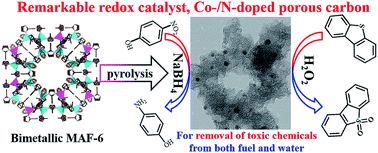Co supported on N-doped carbon, derived from bimetallic azolate framework-6: a highly effective oxidative desulfurization catalyst†
Abstract
Bimetallic (Zn and Co) azolate framework-6s (BMMAF-6s) (composed of Zn and Co in various compositions) were firstly synthesized and pyrolyzed to prepare Co supported on N-doped carbons. BMMAF-6-derived carbonaceous materials (MDC-6(xZnyCo)) were highly porous and were composed of Co nanoparticles (5–15 nm) dispersed well on a N-containing carbon matrix. Co-based catalysts, such as MDC-6(75Zn25Co), Co/activated-carbon and Co/reduced-graphene-oxide, were firstly applied as heterogeneous catalysts for purification of fuel via oxidative desulfurization. The results revealed that the catalytic performance of the prepared material is superior not only to that of conventional Co-based catalysts but also to that of reported catalysts including the representative WO3/ZrO2 catalyst. Moreover, the high reactivity of the MDC-6(75Zn25Co) (with facile recyclability) can be explained by the well-dispersed/small Co-nanoparticles and the synergistic effect between Co and N species. Additionally, the material also shows good efficiency in reductive removal of 4-nitrophenol (from water). Finally, the Co-based materials can be suggested firstly as effective catalysts for oxidative desulfurization.



 Please wait while we load your content...
Please wait while we load your content...